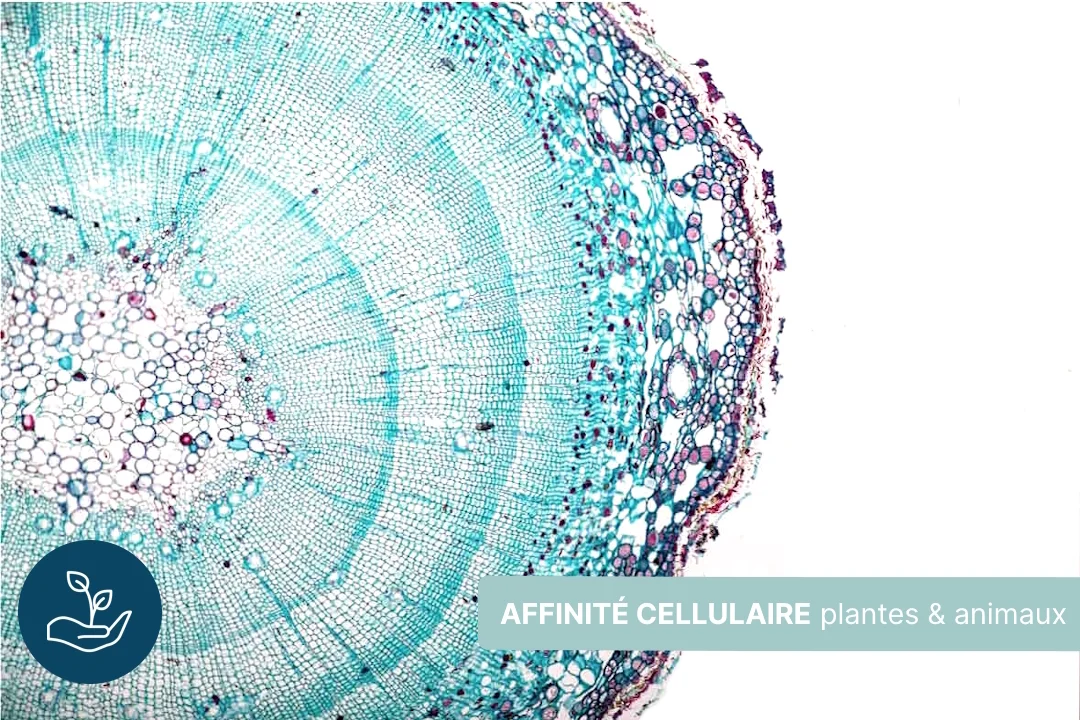Did you know that some plants have cells that bear a striking resemblance to those in our own bodies? For a long time, science considered that animal cells (including human cells) and plant cells were distinct.
However, recent research has shown some astonishing correspondences. This discovery is particularly intriguing as it could pave the way for new advances in medicine and research, both for us and for our pets, such as dogs, cats and horses.
What is cellular affinity?
Cell affinity is the similarity or correspondence between cells of different species. This means that certain animal cells can be identical or very similar to those of plants, and vice versa. This revolutionary discovery has implications for medicine, scientific research and the understanding of biology in general. The cells present in plant and animal organisms are extremely diverse. Animal cells can vary considerably in size and shape, depending on their specific role in the animal's body. Similarly, plant cells are also highly diverse, specializing in distinct functions such as photosynthesis, growth and water regulation.
However, despite their diversity, there are certain similarities between animal and plant cells. For example, both have a cell membrane that protects their internal contents. They also share organelles. These specialized structures, such as mitochondria, vacuoles and ribosomes, have specific functions within the cell. Animal and plant cells also share certain cellular processes, such as the transcription of DNA into RNA and the translation of RNA into proteins.
Of course, there are also significant differences between animal and plant cells. For example, plant cells have a rigid cell wall that gives them their characteristic shape, while animal cells are more flexible. What's more, plant cells contain chloroplasts, the organelles responsible for photosynthesis, a process that uses light energy to produce carbohydrates, which is not found on the animal side.
Finally, there are differences in their life cycles. Plant cells undergo continuous cell division, enabling them to regenerate easily. Animal cells, on the other hand, have a limited lifespan and undergo a process called apoptosis, where the cell dies in a programmed manner.

Unexpected cellular similarities between plants & animals
Scientists have made a surprising discovery by observing the cells of the fly-killing plant, also known as the fly-catching dionaea. They found that these cells bear a strong resemblance to the glandular cells of the human stomach. The latter are specialized in the production of digestive enzymes, which break down ingested proteins, and the plant uses them to digest the insects it captures.
What's more, the researchers also noted striking similarities between the sensory cells of animals and plants. Plant sensory cells, known as contact cells, have the ability to detect mechanical stimuli such as pressure or vibration. In turn, they trigger a response, for example, the closing of the leaves of the fly-catching dionaea when an insect lands on them. This mechanism strikingly echoes reflexes and touch in humans and animals.
These recent discoveries of cellular affinity between animals and plants raise fascinating questions about the nature of life andevolution. Scientists are wondering why similar cells have evolved independently in organisms as different as plants and animals. This, in turn, calls into question the conventional idea of plants and animals as two distinct and separate worlds.
Among the theories raised, the researchers speculate that faced with similar evolutionary pressures - such as the need to find food sources and defend against predators - plant cells evolved to be able to capture insects and digest them, while animal cells evolved to respond to various environmental stimuli.
Possible medical applications of cell affinity
Although the medical implications of the cellular affinity between plants and animals are not yet clear, it is possible to foresee concrete applications for the health of our pets. Dog, cat and horse owners can already use medicinal plants to alleviate certain health problems in their pets.
Interestingly, some plants have long been used for their medicinal properties in humans, and may also be beneficial to pets. However, it's important to remember that not all plants are safe for pets. Some plants, such as lily of the valley, lily and oleander, are toxic to animals and can cause symptoms ranging from diarrhoea to paralysis and even death. So, before treating your pet with herbal remedies, make sure you use natural natural supplements created and produced by professionals. Ultimately, it's essential to consult a veterinarian before giving your pet any herbs or natural remedies.
All in all, the cellular affinity between plants and animals is an exciting discovery that raises many questions about the evolution and nature of life. Although much remains to be discovered about the potential medical implications for our pets, this discovery could lead to new advances in veterinary medicine and animal health.
Need advice on natural herbal remedies for your pets? Ask us your questions in the comments section.














